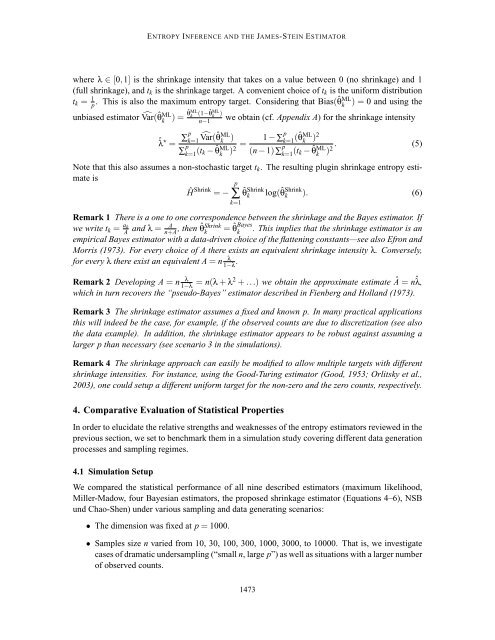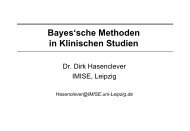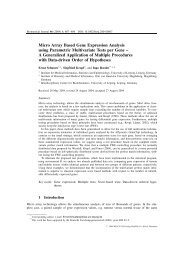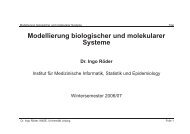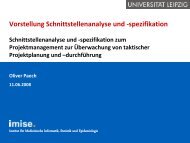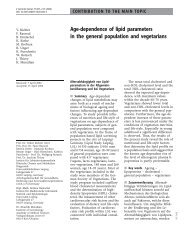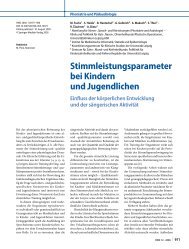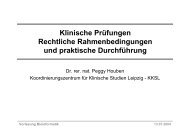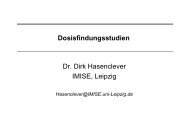Entropy Inference and the James-Stein Estimator, with Application to ...
Entropy Inference and the James-Stein Estimator, with Application to ...
Entropy Inference and the James-Stein Estimator, with Application to ...
Create successful ePaper yourself
Turn your PDF publications into a flip-book with our unique Google optimized e-Paper software.
ENTROPY INFERENCE AND THE JAMES-STEIN ESTIMATOR<br />
where λ ∈ [0,1] is <strong>the</strong> shrinkage intensity that takes on a value between 0 (no shrinkage) <strong>and</strong> 1<br />
(full shrinkage), <strong>and</strong> t k is <strong>the</strong> shrinkage target. A convenient choice of t k is <strong>the</strong> uniform distribution<br />
t k = 1 p<br />
. This is also <strong>the</strong> maximum entropy target. Considering that Bias(ˆθ<br />
ML<br />
k<br />
) = 0 <strong>and</strong> using <strong>the</strong><br />
unbiased estima<strong>to</strong>r ̂Var(ˆθ ML<br />
k<br />
) =<br />
ˆθ ML<br />
k<br />
(1−ˆθ ML<br />
k )<br />
n−1<br />
we obtain (cf. Appendix A) for <strong>the</strong> shrinkage intensity<br />
ˆλ ⋆ = ∑p k=1 ̂Var(ˆθ<br />
ML<br />
k<br />
)<br />
∑ p k=1 (t k − ˆθ ML<br />
k<br />
) = 1 − ∑ p k=1<br />
(ˆθ<br />
ML<br />
k<br />
) 2<br />
2 (n − 1)∑ p k=1 (t k − ˆθ ML<br />
(5)<br />
k<br />
) 2.<br />
Note that this also assumes a non-s<strong>to</strong>chastic target t k . The resulting plugin shrinkage entropy estimate<br />
is<br />
Ĥ Shrink = −<br />
p<br />
∑<br />
k=1<br />
ˆθ Shrink<br />
k log(ˆθ Shrink<br />
k ). (6)<br />
Remark 1 There is a one <strong>to</strong> one correspondence between <strong>the</strong> shrinkage <strong>and</strong> <strong>the</strong> Bayes estima<strong>to</strong>r. If<br />
we write t k = a k<br />
A <strong>and</strong> λ = A<br />
n+A , <strong>the</strong>n ˆθ Shrink<br />
k<br />
= ˆθ Bayes<br />
k<br />
. This implies that <strong>the</strong> shrinkage estima<strong>to</strong>r is an<br />
empirical Bayes estima<strong>to</strong>r <strong>with</strong> a data-driven choice of <strong>the</strong> flattening constants—see also Efron <strong>and</strong><br />
Morris (1973). For every choice of A <strong>the</strong>re exists an equivalent shrinkage intensity λ. Conversely,<br />
for every λ <strong>the</strong>re exist an equivalent A = n λ<br />
1−λ .<br />
Remark 2 Developing A = n λ<br />
1−λ = n(λ + λ2 + ...) we obtain <strong>the</strong> approximate estimate  = nˆλ,<br />
which in turn recovers <strong>the</strong> “pseudo-Bayes” estima<strong>to</strong>r described in Fienberg <strong>and</strong> Holl<strong>and</strong> (1973).<br />
Remark 3 The shrinkage estima<strong>to</strong>r assumes a fixed <strong>and</strong> known p. In many practical applications<br />
this will indeed be <strong>the</strong> case, for example, if <strong>the</strong> observed counts are due <strong>to</strong> discretization (see also<br />
<strong>the</strong> data example). In addition, <strong>the</strong> shrinkage estima<strong>to</strong>r appears <strong>to</strong> be robust against assuming a<br />
larger p than necessary (see scenario 3 in <strong>the</strong> simulations).<br />
Remark 4 The shrinkage approach can easily be modified <strong>to</strong> allow multiple targets <strong>with</strong> different<br />
shrinkage intensities. For instance, using <strong>the</strong> Good-Turing estima<strong>to</strong>r (Good, 1953; Orlitsky et al.,<br />
2003), one could setup a different uniform target for <strong>the</strong> non-zero <strong>and</strong> <strong>the</strong> zero counts, respectively.<br />
4. Comparative Evaluation of Statistical Properties<br />
In order <strong>to</strong> elucidate <strong>the</strong> relative strengths <strong>and</strong> weaknesses of <strong>the</strong> entropy estima<strong>to</strong>rs reviewed in <strong>the</strong><br />
previous section, we set <strong>to</strong> benchmark <strong>the</strong>m in a simulation study covering different data generation<br />
processes <strong>and</strong> sampling regimes.<br />
4.1 Simulation Setup<br />
We compared <strong>the</strong> statistical performance of all nine described estima<strong>to</strong>rs (maximum likelihood,<br />
Miller-Madow, four Bayesian estima<strong>to</strong>rs, <strong>the</strong> proposed shrinkage estima<strong>to</strong>r (Equations 4–6), NSB<br />
und Chao-Shen) under various sampling <strong>and</strong> data generating scenarios:<br />
• The dimension was fixed at p = 1000.<br />
• Samples size n varied from 10, 30, 100, 300, 1000, 3000, <strong>to</strong> 10000. That is, we investigate<br />
cases of dramatic undersampling (“small n, large p”) as well as situations <strong>with</strong> a larger number<br />
of observed counts.<br />
1473


